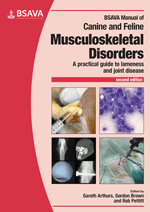
Full text loading...

Conditions affecting the structure and function of the carpus are common in small animal practice and can have debilitating consequences for thoracic limb function. This chapter covers the key aspects of anatomy, investigations, congenital abnormalities, developmental abnormalities, traumatic carpal injuries and arthrodesis. Includes Quick Reference Guide to Imaging Techniques by Thomas W. Maddox. Operative Techniques: Pancarpal arthrodesis; Partial carpal arthrodesis.
The carpus, Page 1 of 1
< Previous page | Next page > /docserver/preview/fulltext/10.22233/9781910443286/9781910443286.20-1.gif

Full text loading...























